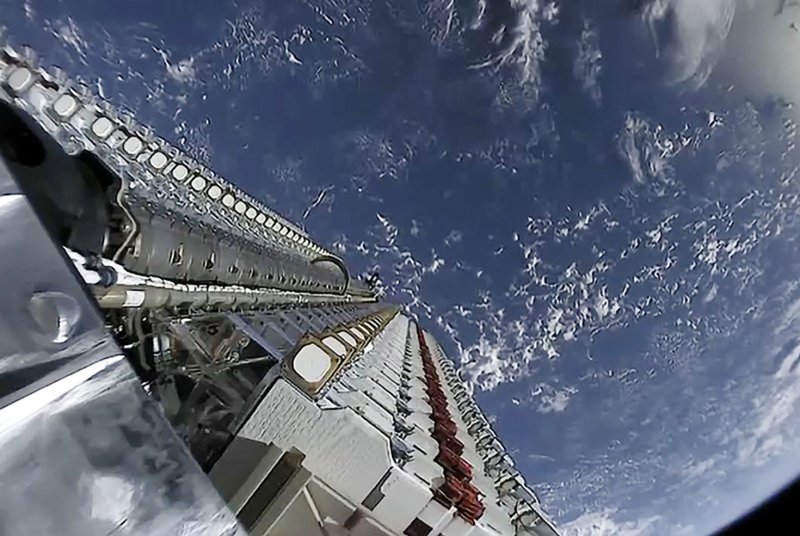A SpaceX Falcon 9 rocket successfully launched 60 Starlink satellites from Space Launch Complex 40 at Cape Canaveral Air Force Station, Florida, on May 23, 2019. SpaceX's Starlink is a next-generation satellite network capable of connecting the globe. File Photo by SpaceX/UPI |
License Photo
Nov. 11 (UPI) -- On Monday, SpaceX's Falcon 9 rocket is scheduled to deliver 60 small satellites into orbit.
The new batch of satellites will bring the Starlink constellation population to 120. As part of its satellite Internet operation, SpaceX plans to launch some 12,000 satellites over the next half-decade.
SpaceX isn't the only company trying to build a satellite constellation capable of providing global Internet coverage. Last winter, OneWeb launched six small satellites. Tests confirmed the mini constellation produces a serviceable signal, and the company expects to launch another 60 satellites in early 2020.
OneWeb, which is targeting an initial constellation population of 650, and later 2,000, expects to begin offering service in the Arctic by the end of 2020 and global coverage in 2021.
SpaceX expects to launch several hundred Starlink satellites in 2020 and begin offering service by the end of the year.
There's more competition on the way. Richard Branson's Virgin Group, Boeing, Amazon and LeoSat Enterprises, a Washington, D.C., company are all in the early stages of pursuing satellite Internet constellations.
As the newest space race heats up, some veterans of the communications industry may be experiencing deja vu.
"Satellite Internet constellations are not new," Olivier de Weck, a professor of aeronautics, astronautics and engineering systems at the Massachusetts Institute of Technology, told UPI. "There were around a dozen constellations that were launched in the 1990s. Some of these are still around, but most went bankrupt or folded."
Most of the early ventures failed because ground-based systems grew quickly and efficiently, meeting the needs of most consumers in the United States and other developed economies.
"Satellite Internet became a small market niche -- for fisherman, for oil and gas operations," de Weck said. "Wherever there was poor cell coverage, that's where they had an advantage. But that wasn't enough to make a profitable business."
Interest in satellite Internet constellations dried up and the market remained dormant for a decade. Now, it's heating up again.
"On the market side, high bandwidth Internet anywhere in the world is very attractive because the Internet has become such a crucial thing in our lives and in business and education," de Weck said.
Over the last twenty years, tremendous gains have been made both in satellite and communications technologies. The innovations of terrestrial communications systems, specifically cellular communications technologies, have yielded smaller, cheaper and more efficient components -- antennas, dishes, transmitters -- which have been rather easily adapted for use in space.
As a result, the newest satellites can do more with less.
"For the same amount of data transferred, the mass of the required satellite is one-tenth what it was 20 years ago," de Weck said.
Likewise, satellite technologies have improved and launch costs have come down. Launching lots of small satellites at once has become increasingly economical.
Once again, building a satellite Internet constellation looks like a profitable endeavor. Only this time, companies are looking to launch thousands, not dozens, of satellites.
The advantages of having more satellites is that, at any given moment, a customer will have better odds of having a direct line between their device, whether a laptop or a smart phone, and one or more satellites.
"With so many up in the sky at the same time, you have a better diversity of available satellites in terms of viewing geometry," de Weck said.
A lot has changed since the last satellite Internet constellations were launched. One thing remains the same: building a profitable satellite Internet business is challenging proposition.
"No one has ever succeeded in making a viable low Earth orbit communication constellation right off the bat," SpaceX CEO Elon Musk told reporters earlier this year. "I do believe we'll be successful, but it is far from a sure thing."















